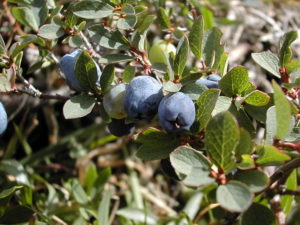
Traditional Ecological Knowledge (TEK) held by indigenous peoples is slowly gaining recognition by scientists as an alternative way of looking at environmental processes over time. In a recent study, researchers used TEK as a means of increasing our understanding of climate change in the Arctic. In order to carry out the study, lead investigator, Alain Cuerrier, along with his collaborators, conducted ethnographic research in three Inuit communities.
The gathering of TEK from cultures like the Inuit is important since it reflects a “cumulative body of knowledge, practice, and beliefs, evolving by adaptive processes and handed down through generations by cultural transmission” (p. 379). TEK is also important since it demonstrates flexibility, problem solving, and ways of mitigating environmental changes that could be valuable to others. The Inuit were chosen for this study since they have already been faced with the growing problem of climate change. In addition, although it is not covered in this article, the Inuit worldview is closely linked to the environment and creates a heightened sensitivity to ecological processes.
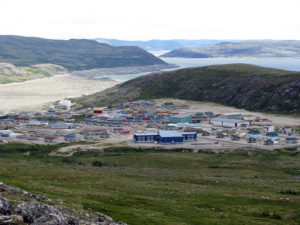
The three communities selected for this study were Umiujag, Kangiqsualujjuaq, and Kangiqsu, all of which are located in the Nunavik region of Quebec. The researchers interviewed 46 individuals throughout the villages and asked questions about changes to plant life, local animals, environmental factors, the landscape in general, and human issues related to climate change.
All of the communities agreed there had been noticeable changes to shrub growth and abundance, changes to mammal populations, and lower water levels. Changes to the weather and seasons were observed more often by the Kangiqsujuag and Umiujag communities, while the people of Kangiqsualujjuag perceived more changes to trees and berries. Information on local vegetation was particularly important since there has been a lack of plant related TEK from this region.
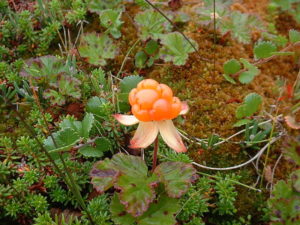
In general, vegetation was changing significantly. Locals told researchers, “The shrubs are bigger everywhere around” and “they [shrubs] are taking over places where blueberries and blackberries used to grow” (p. 384). Also, trees were becoming taller and more abundant. One informant stated, “There were lots of big ones [trees] that they cut down but they are growing back again. The winter is getting smaller” (p. 384).
Changes to berry producing plants are even more significant due to their nutritional value and cultural relevance. Berries not only provide antioxidants and sugars, but the time spent collecting them promotes physical activity, playing yet another a role in Inuit health. Also, the act of harvesting berries provides a connection to the land as well as a means of transmitting intergenerational knowledge.

As a result of rainfall and temperature changes, some berries have become less plentiful and others no longer taste as good as they used to. However, while the productivity of some species may be down, new species are appearing and others may be increasing in abundance. In any case, as plants shift their growth and distribution in response to changing weather patterns, the Inuit will also be forced to adapt their diets and cultural practices.
Animal populations are changing as well. People in all three communities perceived black bear and moose populations as increasing. As one informant said, “The black bears go all the way to my camp now. There are more now…even the moose are coming up too” (p. 386). Canada and snow geese were also said to be increasing. But in contrast, the caribou, seal and narwhal were perceived as diminishing. “It’s been a long time that I’ve seen caribou close to the village…In the 80’s they would pass for hours,” another informant stated (p. 386). Changes in fish populations and insects occurred but were not focused on by this study.
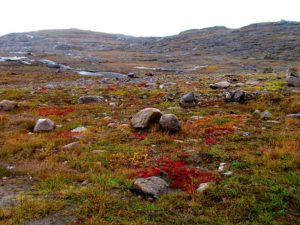
One of the most pressing issues for the Inuit are changes in weather patterns that influence the landscape. First, all of the communities agreed that water levels were lower and the permafrost is thawing as well. According to one informant, “It seems like the lakes are leaking, because the permafrost is not frozen anymore.” Unfortunately, this results in the inability to travel by traditional means. Also, as ice becomes thinner, travelers are at risk of falling through the ice. An earlier article reported that fishing on thinning ice has become more dangerous as well.
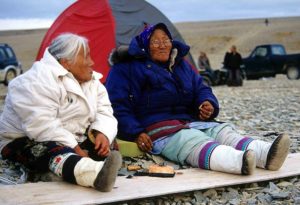
Informants also described how wind and rain patterns have changed. They have become increasingly unpredictable, which is troublesome for a culture dependent on environmental regularities. One person stated, “It’s raining less than before, but harder at a time” (p. 387). Subsequently, sea ice is breaking up and there are decreasing snow levels. The lack of snow creates yet another dilemma since igloos are not possible without it. As a result, many Inuit have been forced to use tents instead. However, despite the negative results of weather variations, the Inuit do see some positive outcomes of seasonal changes such as longer growing seasons and longer ice-free periods for boat travel and tourism.
Overall, these researchers wish to stress the urgent need for more studies on TEK. The knowledge of people such as the Inuit is an invaluable resource in understanding climate change and may aid in the development of strategies to manage or adapt to ensuing environmental changes. TEK is important both culturally and biologically and can no longer be ignored by the larger scientific community as a legitimate source of knowledge.
Cuerrier, Alain, Nicholas D. Brunet, Josè Gèrin-Lajoie, and Ashleigh Downing. 2015. The Study of Inuit Knowledge of Climate Change in Nunavik, Quebec: A Mixed Methods Approach. Human Ecology 43: 379-394.
By Sherrie Alexander, University of Alabama at Birmingham